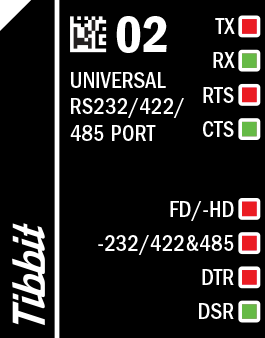#02, M2S: RS232/422/485 Port

Function: Universal RS232/422/485 port
Form factor: M2S
Category: Input/output module
Power requirements: 5V/40mA


Details
This is a "full" serial port that can be electronically programmed to work in RS232, RS422, or RS485 mode. This Tibbit is based on the Sipex SP337 universal transceiver.
Mode selection is through the FD/–HD and –232/422&485 control lines:
| Table #1 — RS232/422/485 Mode Selection | ||
|
Mode |
FD/–HD |
–232/422&485 |
|
RS232 |
HIGH |
LOW |
|
RS422 |
HIGH |
HIGH |
|
RS485 |
LOW |
HIGH |
When unconnected, FD/–HD defaults to HIGH, while –232/422&485 defaults to LOW. This means that the RS232 mode will be selected.
In the RS232 mode, the port has RX, TX, RTS, CTS, DTR, and DSR signals. This is a full-duplex mode.
In the RS422 mode, the port has +/–RX, +/–TX, +/–RTS, and +/–CTS signal pairs. This is a full-duplex mode.
In the RS485 mode, the port has only +/–RX and +/–TX signal pairs. This is a half-duplex mode, so you can connect +RX to +TX and –RX to –TX. This will allow your system to communicate over a single twisted pair. Direction control is through the RTS line — the line should be LOW for data input and HIGH for output.
For "normal" RS232/422/485 applications, this Tibbit has to be connected to the TX and RX lines of the CPU's UART (see [SER]). Planning to use RTS/CTS flow control as well? An interrupt line must be available, too (see [INT]).
Combining Tibbit #02 with Tibbit #19 (DB9M connector) will create a serial port with the following pin assignments on the DB9M:
| Table #2 — DB9M Pin Assignments | |||
|
RS232 |
RS422 |
RS485 |
|
|
#1 |
<No connection> |
RTS– (output) |
<No connection> |
|
#2 |
RX (input) |
RX– (input) |
RX– (input) |
|
#3 |
TX (output) |
TX+ (output) |
TX+ (output) |
|
#4 |
DTR (output) |
TX– (output) |
TX– (output) |
|
#5 |
Ground |
Ground |
Ground |
|
#6 |
DSR (input) |
RX+ (input) |
RX+ (input) |
|
#7 |
RTS (output) |
RTS+ (output) |
<No connection> |
|
#8 |
CTS (input) |
CTS+ (input) |
<No connection> |
|
#9 |
<No connection> |
CTS– (input) |
<No connection> |
The above pin assignments are the same we use on all our devices with a universal port (for example, see the serial port of the DS1102).
You can also combine Tibbit #02 with #20 (nine terminal blocks).
LEDs
There are eight LEDs: five red and three green. The red LEDs are connected to the TX, RTS, DTR, FD/–HD, and –232/422&485 lines. The green ones are for RX, CTS, and DSR. All LEDs are buffered (with logic gates) and light up for the LOW state of control lines.
